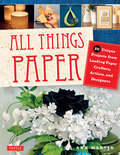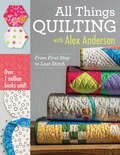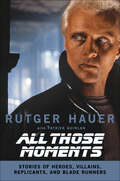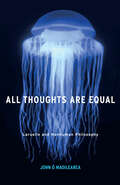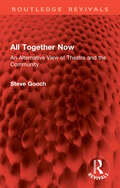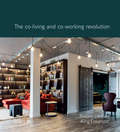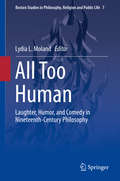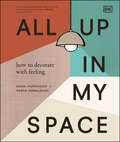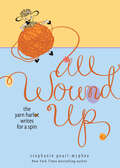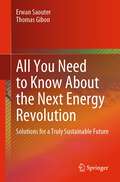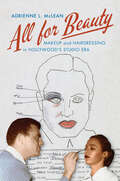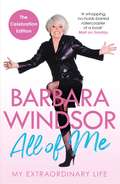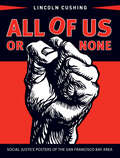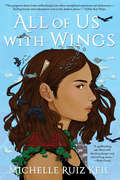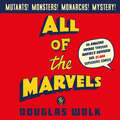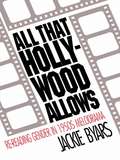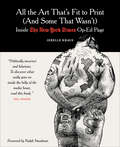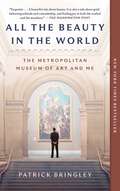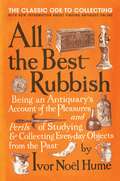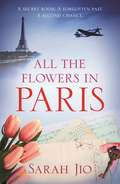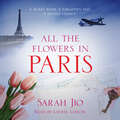- Table View
- List View
All Things Paper
by Ann MartinAnn Martin has searched the world over for unique and beautiful paper crafts to feature on her popular website--AllThingsPaper.net. In this book, she gathers completely new projects and shows how each is created, step-by-step.All of the paper products in this book are designed by respected paper craft artists, such as Benjamin John Coleman, Patricia Zapata, and Richela Fabian Morgan, who have been making amazing things with paper for many years. Each of the projects, from simple to more complex, has easy-to-follow instructions and detailed photos enabling you to create your own! These colorful and impressive pieces include art objects to display at home as well as items which have practical uses. All of the pieces make a wonderful keepsake or a gift that expresses the beauty, elegance, and versatility of paper.Projects include:Candle LuminariesCitrus Slice CoastersMysterious Stationery BoxEveryday Tote BagSilver Orb PendantFine Paper Yarn NecklaceWedding Cake CardPerfect Journey Journal
All Things Quilting with Alex Anderson: From First Step to Last Stitch
by Alex AndersonThis comprehensive guide by the host of The Quilt Show covers everything you need to know to become a master quilter.Alex Anderson has taught and inspired countless quilters around the world through her television programs, fabric lines, and numerous books. In All Things Quilting with Alex Anderson, she packs her most indispensable knowledge and advice into a single volume. Encyclopedic in its scope, it covers quilting techniques, essential tools, binding basics, piecing and appliqué, and much more. It is both a master class for novices and an essential reference for experienced quilters.
All Those Moments: Stories of Heroes, Villains, Replicants, and Blade Runners
by Rutger Hauer Patrick QuinlanThe Blade Runner star recounts his eventful life and acting career, from joining the merchant navy to working with Hollywood’s biggest directors.Rutger Hauer has dazzled audiences for years with his creepy, inspiring, and villainous character portrayals. He came to mainstream prominence as a machine more human than his creators in Blade Runner, terrified us as a hitchhiker bent on his own death in The Hitcher, and portrayed a lovestruck king who nightly transformed into a marauding wolf in Ladyhawke.While fans are well acquainted with Hauer’s unforgettable on-screen performances, his movie career was nothing compared to his real-life adventures. Born in the Netherlands during WWII, he grew up in a poor family that nourished his creativity. After travelling the world with the Dutch merchant navy, he pursued his love of acting. From working with a traveling theater troupe to his breakout European performance in Turkish Delight and working with legendary directors such as Paul Verhoeven (RoboCop and Basic Instinct) and Ridley Scott (Alien and Gladiator), Hauer has collected All Those Moments here.
All Thoughts Are Equal: Laruelle and Nonhuman Philosophy (Posthumanities #34)
by John Ó MaoilearcaAll Thoughts Are Equal is both an introduction to the work of French philosopher François Laruelle and an exercise in nonhuman thinking. For Laruelle, standard forms of philosophy continue to dominate our models of what counts as exemplary thought and knowledge. By contrast, what Laruelle calls his &“non-standard&” approach attempts to bring democracy into thought, because all forms of thinking—including the nonhuman—are equal.John Ó Maoilearca examines how philosophy might appear when viewed with non-philosophical and nonhuman eyes. He does so by refusing to explain Laruelle through orthodox philosophy, opting instead to follow the structure of a film (Lars von Trier&’s documentary The Five Obstructions) as an example of the non-standard method. Von Trier&’s film is a meditation on the creative limits set by film, both technologically and aesthetically, and how these limits can push our experience of film—and of ourselves—beyond what is normally deemed &“the perfect human.&”All Thoughts Are Equal adopts film&’s constraints in its own experiment by showing how Laruelle&’s radically new style of philosophy is best presented through our most nonhuman form of thought—that found in cinema.
All Together Now: An Alternative View of Theatre and the Community (Routledge Revivals)
by Steve GoochIn All Together Now (first published in 1984), Steve Gooch, himself a playwright with extensive experience of ‘community theatre’, looks at the relationship of the theatre to the community in which it takes place. Taking the work of contemporary ‘community theatre’ as a stimulus, he gives a ‘behind-the-scenes’ analysis of the failure of commercial theatre—in the subsidised sector as well as the West End—to transcend the mechanisms of box-office and tradition, and to play a vital and integral part in the life of its audience. Examining the initiatives of small theatres and touring companies in the seventies, Gooch looks critically at their work practices and forms of organisation and draws some positive pointers for the future.As much about the internal workings of theatre production as about the content and outward face of its shows, All Together Now offers new insights into a culture divided between ‘high and low’, ‘popular and serious’.
All Together Now: The co-working and co-living revolution
by Naomi Cleaver Amy FrearsonCollaborative spaces have been hailed as either the solution to the 21st century’s culture of overwork and broken housing market, or as an unworkable and impractical aspiration. Designing for such spaces has its particular challenges and considerations, especially in how to deliver attractive, healthy and efficient collaborative places. A practical and inspirational design guide, this book draws on the author's own experience, as well as the work of others, offering workable and practical solutions, and showcases a huge variety of different kinds of collaborative spaces across the globe. Including detailed and illustrated case studies across the co-living, co-working typologies – both new build and conversion, at different scales and in different settings – it concludes with a best practice toolkit, giving practical advice and lessons for all designers working at any scale. Case studies include: *The Project, Hoxton, London *Outpost, Bali *Venn, Tel Aviv
All Too Human: Laughter, Humor, and Comedy in Nineteenth-Century Philosophy (Boston Studies in Philosophy, Religion and Public Life #7)
by Lydia L. MolandThis book offers an analysis of humor, comedy, and laughter as philosophical topics in the 19th Century. It traces the introduction of humor as a new aesthetic category inspired by Laurence Sterne’s "Tristram Shandy" and shows Sterne’s deep influence on German aesthetic theorists of this period. Through differentiating humor from comedy, the book suggests important distinctions within the aesthetic philosophies of G.W.F. Hegel, Karl Solger, and Jean Paul Richter. The book links Kant’s underdeveloped incongruity theory of laughter to Schopenhauer’s more complete account and identifies humor’s place in the pessimistic philosophy of Julius Bahnsen. It considers how caricature functioned at the intersection of politics, aesthetics, and ethics in Karl Rosenkranz’s work, and how Kierkegaard and Nietzsche made humor central not only to their philosophical content but also to its style. The book concludes with an explication of French philosopher Henri Bergson’s claim that laughter is a response to mechanical inelasticity.
All Up In My Space: Discover Your Own Interior Design Style
by Emma Hopkinson Robyn DonaldsonYou have just gotten the keys, unpacked the boxes, and officially moved into your new apartment. Or maybe you have lived in your home for a couple years and it is in need of some extra love and care to make it into the place you always dreamt it would be. But where do you start? Should you repaint the walls or replace the floors? Are you a minimalist or a maximalist? What is missing?In this beautiful book, from the authors and creators of the award-winning blog All Up In My Space, Robyn Donaldson and Emma Hopkinson share their abundance of knowledge on interior design to help you figure out how to make your space your own. Learn about how to decorate a rental property without losing your deposit, discover how to switch things up in your home without having to change everything, and identify what type of interior design style suits you.With practical tips for things like painting and vintage shopping and advice on where to purchase classy yet budget-conscious furniture, this book is perfect for all home lovers. Each chapter will take you on a tour, room by room, to reveal cheaper but fabulous ways of adding your own style and flair to your home. Should you add a splash of paint, or do you need to rearrange the furniture? This captivating and beautifully illustrated book will teach and show you exactly what home really should feel like.Whether you are an introvert or an extrovert, live in an apartment or a house, or are on a tight budget, this book will make the perfect gift for all and will provide you with all the tips and tricks you need to make your space truly Instagram-able.
All Wound Up: The Yarn Harlot Writes for a Spin
by Stephanie Pearl-McPheeThe New York Times–bestselling author of Yarn Harlot returns with more witty stories about knitting, motherhood, friendship, and more.In this all-new collection of yarns, New York Times–bestselling author and self-proclaimed yarn Harlot Stephanie Pearl-McPhee is all wound up about life, motherhood, losing her beloved washing machine, and, of course, knitting.With trademark humor and wit that have sustained her through thick and thin, including a few misshapen sweaters and an indoor water balloon fight among her otherwise darling daughters, Pearl-McPhee deftly examines knitting, parenting, friendship, and—gasp!—even crocheting in essays that are at times touching, often hilarious, and always entertaining.Praise for Yarn Harlot“A sort of David Sedaris-like take on knitting—laugh-out-loud funny most of the time and poignantly reflective when it’s not cracking you up.” —Library Journal“Pearl-McPhee turns both typical and unique knitting experiences into very funny and articulate prose.” —Meg Swansen, Schoolhouse Press“I laughed until my stitches fell helplessly from my needles!” —Lucy Neatby, author of Cool Socks Warm Feet
All You Need to Know About the Next Energy Revolution: Solutions for a Truly Sustainable Future
by Erwan Saouter Thomas GibonClimate change is a reality that cannot now be disputed and solutions exist, whether technological or societal. However, it is essential to understand their capacity to meet a demand for energy and resources that will continue to grow. Faced with the confusion of messages, the multiplicity, and, sometimes, the naivety of the roadmaps for achieving a carbon-neutral world, this concise book proposes a return to the fundamentals that we should all know before we can choose the type of development we want. It invites us to move away from dogmatic positions, preconceived, and partisan ideas and to become aware that all the choices available to us have advantages and disadvantages, and that these must be rigorously quantified in order to prevent today's solutions from becoming tomorrow's disasters.
All about Almodóvar: A Passion for Cinema
by Brad Epps Despina KakoudakiOne of world cinema&’s most exciting filmmakers, Pedro Almodóvar has been delighting, provoking, arousing, shocking, and—above all—entertaining audiences around the globe since he first burst on the international film scene in the early 1980s. All about Almodóvar offers new perspectives on the filmmaker&’s artistic vision and cinematic preoccupations, influences, and techniques. Through overviews of his oeuvre and in-depth analyses of specific films, the essays here explore a diverse range of subjects: Almodóvar&’s nuanced use of television and music in his films; his reworkings of traditional film genres such as comedy, horror, and film noir; his penchant for melodrama and its relationship to melancholy, violence, and coincidence; his intricate questioning of sexual and national identities; and his increasingly sophisticated inquiries into visuality and its limits. Closing with Almodóvar&’s own diary account of the making of Volver and featuring never-before-seen photographs from El Deseo production studio, All about Almodóvar both reflects and illuminates its subject&’s dazzling eclecticism.
All for Beauty: Makeup and Hairdressing in Hollywood's Studio Era (Techniques of the Moving Image)
by Adrienne L. McLeanEver wonder why so many stars and featured players, male or female, in movies of Hollywood’s “Golden Age” look like they just stepped out of a beauty parlor even if the story places them in a jungle, a hospital bed, or the ancient past? All for Beauty examines how and why makeup and hairdressing evolved as crafts designed partly to maintain the white flawlessness of men and women as a value in the studio era. The book pays particular attention to the labor force, exploring the power and influence of cosmetics inventor and manufacturer Max Factor and the Westmore dynasty of makeup artists but also the contributions of others, many of them women, whose names are far less known. At the end of the complex, exciting, and at times dismaying chronicle, it is likely that readers will never again watch Hollywood films without thinking about the roles of makeup and hairdressing in creating both fictional characters and stars as emblems of an idealized and undeniably mesmerizing visual perfection.
All of Me: My Extraordinary Life
by Barbara WindsorThis ebook edition contains the full text version as per the book. Doesn't include original photographic and illustrated material. Born in the East End of London just before the war, Barbara Windsor made her first stage appearance at the age of 13. From her early roles as the original Carry On dolly bird to her hit as Peggy Mitchell in the award-winning BBC drama EastEnders, her spectacular success in theatre, film and TV has made her a British icon - the Cockney kid with a dazzling smile and talent to match. Here, for the first time, she talks in depth about the people and events that have shaped her career: her lonely childhood, her doomed marriage to Ronnie Knight, her legendary affairs, how she has never let her fans down whatever her personal anguish. This is the heart-warming story of a courageous woman and consummate performer who has always made sure the show goes on.
All of Me: My Extraordinary Life - The Most Recent Autobiography by Barbara Windsor
by Barbara WindsorTHE HEART-WARMING AUTOBIOGRAPHY BY BARBARA WINDSOR CHRONICLING HER EARLY CHILDHOOD IN LONDON'S EAST END TO RECEIVING A DBE IN 2000'A whopping, no-holds-barred rollercoaster of a book' Mail on Sunday`Barbara Windsor emerges from these pages as a personality both strong and sunny' Sunday TelegraphBorn in the East End of London just before the war, Barbara Windsor made her first stage appearance at the age of 13. From her early roles as the original Carry On dolly bird to her longest role as Peggy Mitchell in the award-winning BBC drama EastEnders, her spectacular success in theatre, film and TV has made her a British icon - the Cockney kid with a dazzling smile and talent to match.Here, for the first time, she talks in depth about the people and events that have shaped her career: her lonely childhood, her doomed marriage to Ronnie Knight, her legendary affairs, how she never let her fans down whatever her personal anguish. This is the heart-warming story of a courageous woman and consummate performer who has always made sure the show goes on.'By living up to its title alone it makes a nonsense of every other showbiz bleat 'n' brag ever put to paper' Julie Burchill'Infinitely more interesting than the sentimental schmaltz we have read about her before' Lynn Barber, Daily Telegraph
All of Us or None: Social Justice Posters of the San Francisco Bay Area
by Lincoln CushingThis long-awaited catalog of political posters pays homage to an influential and populist art movement that has created some of the most enduring imagery of our time. In All of Us or None, author Lincoln Cushing examines key selections from a remarkable archive of over 24,000 posters amassed by free speech movement activist, author, and educator Michael Rossman over the course of thirty years. This inspiring collection of Bay Area posters illuminates the history of this ad-hoc and ephemeral art form, celebrating its unique capacity to infuse contemporary issues with the urgency and energy of the eternal fight for justice.
All of Us or None: Social Justice Posters of the San Francisco Bay Area
by Lincoln CushingA riveting survey of almost three hundred posters, revealing a history of Bay Area artists, activists, and movements from the 1960s to 2012.This catalog of political posters pays homage to an influential and populist art movement that has created some of the most enduring imagery of our time. In All of Us or None, author Lincoln Cushing examines key selections from a remarkable archive of over 24,000 posters amassed by free speech movement activist, author, and educator Michael Rossman over the course of thirty years. This inspiring collection of Bay Area posters illuminates the history of this ad-hoc and ephemeral art form, celebrating its unique capacity to infuse contemporary issues with the urgency and energy of the eternal fight for justice.Featuring posters on topics as diverse as civil rights, war, poverty, the environment, music, women’s liberation, fine art, and gentrification, All of Us or None shows us why the Bay Area was such fertile breeding ground for the genre and why it arguably produced more independent political posters than anywhere else on earth. Here is an exhilarating history of artists, studios, printshops, distributors, activists, icons, and changemakers—among them R. Crumb, Stanley Mouse, Cesar Chavez, Max Scherr, Emory Douglas, Angela Davis, the San Francisco Mime Troupe, Bill Graham, and Pete Seeger—together raising their voices in opposition to the status quo.In spring of 2012, the Oakland Museum of California presented its first comprehensive exhibition of this recently acquired treasure; the show, along with this book, presented an unbroken narrative of passionate social justice printmaking from the mid-1960s to 2012.“This engaging catalogue surveys nearly 300 of the late Michael Rossman’s enormous collection of over 24,000 San Francisco Bay Area social justice posters . . . . With fluid, highly accessible prose, Cushing traces the lineage of images that have now become iconic, such as Frank Cieciorka’s often quoted clenched fist, or the Black Panther Party’s panther symbol as rendered by Emory Douglas and others.” —Publishers Weekly“An extremely remarkable and useful book: remarkable because it brings back so many of the memorable images of rebellion political, cultural, and both together from a past now rapidly receding, and useful because in our new era of protest, creative expression in artistic forms is more badly needed than ever. Lincoln Cushing, a distinguished scholar of political art, has given us a small masterpiece.” —Paul Buhle, publisher of the SDS magazine Radical America and author of more than forty books on radical politics and culture
All of Us with Wings
by Michelle Ruiz KeilThis young adult fantasy debut about love, found family, and healing is &“a fantastical ode to the Golden City&’s postpunk era,&” told through the eyes of a Mexican-American girl (Entertainment Weekly). &“Complex and beautiful, blending folklore, San Franciscan history, the music scene, vampires, magic . . . hard to put down.&” —School Library Journal Seventeen-year-old Xochi is alone in San Francisco, running from her painful past: the mother who abandoned her, the man who betrayed her. Then one day, she meets Pallas, a precocious twelve-year-old who lives with her rockstar family in one of the city&’s storybook Victorians. Xochi accepts a position as Pallas&’s live-in governess and quickly finds her place in the girl&’s tight-knit household, which operates on a free-love philosophy and easy warmth despite the band&’s growing fame. But on the night of the Vernal Equinox, as a concert afterparty rages in the house below, Xochi and Pallas perform a riot-grrrl ritual in good fun, accidentally summoning a pair of ancient beings bound to avenge the wrongs of Xochi&’s past. She would do anything to preserve her new life, but with the creatures determined to exact vengeance on those who&’ve hurt her, no one is safe—not the family Xochi&’s chosen, nor the one she left behind.
All of the Marvels: An Amazing Voyage into Marvel's Universe and 27,000 Superhero Comics
by Douglas WolkOver the last sixty years, the Marvel superhero comic books have grown into a gigantic mountain in the middle of contemporary culture. They are the longest continuous, selfcontained work of fiction ever created: over half a million pages to date - and growing. Thousands of writers and artists have contributed to it. Every schoolchild recognizes itsprotagonists: Spider-Man, the Avengers, the X-Men. And not even the people telling the story have read the whole thing - nobody's supposed to. So, of course, that's what Douglas Wolk did: he read all 27,000 comics that make up the Marvel universe thus far, from Alpha Flight to Omega the Unknown.All of the Marvels is a landmark, but ludicrously fun, piece of cultural criticism. Trying to make sense of the ever-expanding mythology, Wolk shows how it reflects a funhouse-mirror history of the past 60 years, from the atomic night-terrors of the Cold War to the technocracy and political divisions of the present day. He observes the Marvel story's progressive visions and its painful stereotypes, its patches of woeful hackwork and stretches of luminous creativity. This is a huge treat for Marvel fans, but it's also a revelation for readers who don't know Doctor Strange from Doctor Doom.Here, truly, are all of the marvels.
All that Hollywood Allows: Re-reading Gender in 1950s Melodrama (Gender And American Culture Ser.)
by Jackie ByarsAll that Hollywood Allows explores the representation of gender in popular Hollywood melodramas of the 1950s. Both a work of feminist film criticism and theory and an analysis of popular culture, this provocative book examines from a cultural studies perspective top-grossing film melodramas, such as A Streetcar Named Desire, From Here to Eternity, East of Eden, Imitation of Life and Picnic. Stereotypically viewed as a complacent and idyllic time, the 1950s were actually a time of dislocation and great social change. Jackie Byars argues that mass media texts of the period, especially films, provide evidence of society's consuming preoccupation with the domestic sphere - the nuclear family and its values - and she shows how Hollywood melodramas interpreted and extended societal debates concerning family structure, sexual divisions of labour, and gender roles. Her readings of these films assess a variety of critical methodologies and approaches to textual analysis, some central to feminist film studies and some previously bypassed by scholars in the field.
All the Art That's Fit to Print (And Some That Wasn't): Inside The New York Times Op-Ed Page
by Jerelle KrausAll the Art That's Fit to Print reveals the true story of the world's first Op-Ed page, a public platform that—in 1970—prefigured the Internet blogosphere. Not only did the New York Times's nonstaff bylines shatter tradition, but the pictures were revolutionary. Unlike anything ever seen in a newspaper, Op-Ed art became a globally influential idiom that reached beyond narrative for metaphor and changed illustration's very purpose and potential. Jerelle Kraus, whose thirteen-year tenure as Op-Ed art director far exceeds that of any other art director or editor, unveils a riveting account of working at the Times. <P><P>Her insider anecdotes include the reasons why artist Saul Steinberg hated the Times, why editor Howell Raines stopped the presses to kill a feature by Doonesbury's Garry Trudeau, and why reporter Syd Schanburg-whose story was told in the movie The Killing Fields-stated that he would travel anywhere to see Kissinger hanged, as well as Kraus's tale of surviving two and a half hours alone with the dethroned peerless outlaw, Richard Nixon.All the Art features a satiric portrayal of John McCain, a classic cartoon of Barack Obama by Jules Feiffer, and a drawing of Hillary Clinton and Obama by Barry Blitt. But when Frank Rich wrote a column discussing Hillary Clinton exclusively, the Times refused to allow Blitt to portray her. Nearly any notion is palatable in prose, yet editors perceive pictures as a far greater threat. Confucius underestimated the number of words an image is worth; the thousand-fold power of a picture is also its curse.Op-Ed's subject is the world, and its illustrations are created by the world's finest graphic artists. The 142 artists whose work appears in this book hail from thirty nations and five continents, and their 324 pictures-gleaned from a total of 30,000-reflect artists' common drive to communicate their creative visions and to stir our vibrant cultural-political pot.
All the Art That's Fit to Print (And Some That Wasn't): Inside The New York Times Op-Ed Page
by Jerelle KrausFrom the New York Times&’s former Op-Ed art director, the true story of the world&’s first Op-Ed page, a public platform that prefigured the blogosphere. Jerelle Kraus, whose thirteen-year tenure as Op-Ed art director far exceeds that of any other art director or editor, unveils a riveting account of working at the Times. Her insider anecdotes include the reasons why artist Saul Steinberg hated the Times, why editor Howell Raines stopped the presses to kill a feature by Doonesbury&’s Garry Trudeau, and why reporter Syd Schanburg—whose story was told in the movie The Killing Fields—stated that he would travel anywhere to see Kissinger hanged, as well as Kraus&’s tale of surviving two and a half hours alone with the dethroned outlaw, Richard Nixon. All the Art features a satiric portrayal of John McCain, a classic cartoon of Barack Obama by Jules Feiffer, and a drawing of Hillary Clinton and Obama by Barry Blitt. But when Frank Rich wrote a column discussing Hillary Clinton exclusively, the Times refused to allow Blitt to portray her. Nearly any notion is palatable in prose, yet editors perceive pictures as a far greater threat. Confucius underestimated the number of words an image is worth; the thousand-fold power of a picture is also its curse . . . Features 142 artists from thirty nations and five continents, and 324 pictures—gleaned from a total of 30,000—that stir our cultural-political pot. &“To discover what really goes on inside the belly of the media beast, read this book.&” —Bill Maher &“In this overflowing treasure chest of ideas, politics and cultural critiques, Kraus proves that &“art is dangerous&” and sometimes necessarily so.&” —Publishers Weekly
All the Beauty in the World: The Metropolitan Museum of Art and Me
by Patrick BringleyA best book of the year from New York Public Library, NPR, the Financial Times, Book Riot, and the Sunday Times (London). A fascinating, revelatory portrait of the Metropolitan Museum of Art and its treasures by a former New Yorker staffer who spent a decade as a museum guard.Millions of people climb the grand marble staircase to visit the Metropolitan Museum of Art every year. But only a select few have unrestricted access to every nook and cranny. They&’re the guards who roam unobtrusively in dark blue suits, keeping a watchful eye on the two million square foot treasure house. Caught up in his glamorous fledgling career at The New Yorker, Patrick Bringley never thought he&’d be one of them. Then his older brother was diagnosed with fatal cancer and he found himself needing to escape the mundane clamor of daily life. So he quit The New Yorker and sought solace in the most beautiful place he knew. To his surprise and the reader&’s delight, this temporary refuge becomes Bringley&’s home away from home for a decade. We follow him as he guards delicate treasures from Egypt to Rome, strolls the labyrinths beneath the galleries, wears out nine pairs of company shoes, and marvels at the beautiful works in his care. Bringley enters the museum as a ghost, silent and almost invisible, but soon finds his voice and his tribe: the artworks and their creators and the lively subculture of museum guards—a gorgeous mosaic of artists, musicians, blue-collar stalwarts, immigrants, cutups, and dreamers. As his bonds with his colleagues and the art grow, he comes to understand how fortunate he is to be walled off in this little world, and how much it resembles the best aspects of the larger world to which he gradually, gratefully returns. In the tradition of classic workplace memoirs like Lab Girl and Working Stiff, All The Beauty in the World is a surprising, inspiring portrait of a great museum, its hidden treasures, and the people who make it tick, by one of its most intimate observers.
All the Best Rubbish
by Ivor Noël HumeOne person's trash is another's treasure! In his newly revised classic, All the Best Rubbish, Ivor NoËl Hume traces the fascinating history of collecting from its recorded beginnings and describes the remarkable detective work that goes into establishing the probable facts about uncovered and often underappreciated treasures. Now expanded with hints, tips, and helpful information about antique-hunting online, All the Best Rubbish is the ideal book for the antiquarian or amateur, the historian or professional collector--for anyone who knows that there's no such thing as "just junk."
All the Flowers in Paris: The most heartbreaking and gripping wartime novel you'll read in 2020
by Sarah JioOne mother's desperate hope for survival. 1943: In occupied Paris, Celine creates bespoke bouquets at her father's flower shop on rue Cler, whilst trying to shield her young daughter from the brutal reality of war. But when an SS officer takes an interest in Celine and her family, all their lives are put in jeopardy...One woman's search for the truth... 2009: Caroline wakes in Paris with no memory of her previous life. Hunting for clues to her identity in her apartment on the rue Cler, she discovers a bundle of letters written by a young widow during the Second World War. As she peels back the layers of the past, Caroline finds new purpose - but Celine's story is unfinished. Desperate to find out the truth, Caroline digs deeper, uncovering dark and dangerous secrets...Can learning the truth about Celine help Caroline unlock the mystery of her past?The compelling and evocative new historical novel from the international bestselling author Sarah Jio. Perfect for fans of The Key by Kathryn Hughes, The Parisians by Marius Gabriel and The Paris Secret by Lily Graham.
All the Flowers in Paris: The most heartbreaking new WW2 novel from international bestselling author you'll read this year
by Sarah JioOne mother's desperate hope for survival. 1943: In occupied Paris, Celine creates bespoke bouquets at her father's flower shop on rue Cler, whilst trying to shield her young daughter from the brutal reality of war. But when an SS officer takes an interest in Celine and her family, all their lives are put in jeopardy...One woman's search for the truth... 2009: Caroline wakes in Paris with no memory of her previous life. Hunting for clues to her identity in her apartment on the rue Cler, she discovers a bundle of letters written by a young widow during the Second World War. As she peels back the layers of the past, Caroline finds new purpose - but Celine's story is unfinished. Desperate to find out the truth, Caroline digs deeper, uncovering dark and dangerous secrets...Can learning the truth about Celine help Caroline unlock the mystery of her past?The compelling and evocative new historical novel from the international bestselling author Sarah Jio. Perfect for fans of The Key by Kathryn Hughes, The Parisians by Marius Gabriel and The Paris Secret by Lily Graham.
